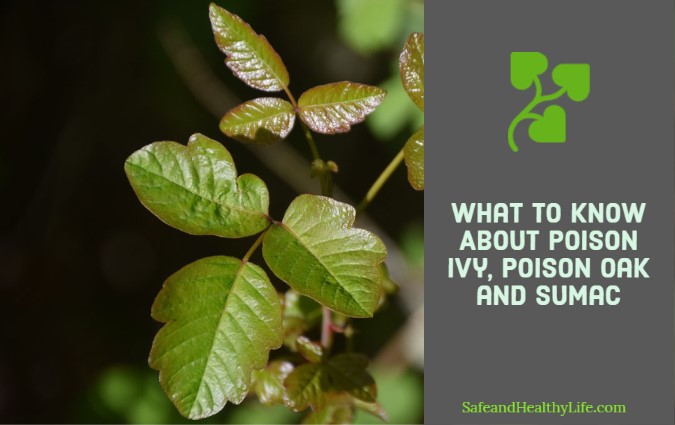
For many people, coming across poison ivy, poison oak or sumac is an unforgettable experience. As a part of the Anacardiaceae family, these plants protect themselves by producing an irritant called urushiol, which causes an itchy, painful rash.
This irritant causes a swift allergic reaction in the vast majority of people, though not always at the first point of contact.
Even more confusingly, not all people experience a reaction to the irritant, leaving them seemingly immune to the misery it causes.
If an allergic reaction does occur, it causes a rash that can stick around for up to a month. Oftentimes, the rash resolves on its own, though severe reactions often require medical care.
Here’s a look at everything you need to know about coming into contact with these wily plants.
Identifying These Poisonous Plants
Direct contact with these plants is the most common way to end up with urushiol on your skin. It’s a valuable exercise to get your children to learn to identify them. There are even rhymes to help people remember, such as “Leaves of three, leave them be”.
Overall people should avoid plants that have:
- Clusters of three leaves
- Long middle stems
- Glossy leaves
- Small tendrils along their stems
Although poison ivy and poison oak have clusters of three leaves, sumac is a bit different. This plant has 7 to 13 pairs of leaves along each branch along with one solitary leaf at the tip.
All three of these plants take on an orange, pink, or reddish hue in the spring, and then turn green in the summer. By the fall, the leaves move from red to yellow to brown before they fall off.
Even after the leaves have fallen, the plants are not safe to touch. Urushiol lurks in the stems and roots as well, making them a year-round hazard.
How Urushiol Makes Its Way Around
Urushiol is an oil that stays on the skin, clothing and other surfaces until thoroughly washed away. For that reason, people can unknowingly spread it to others well before the allergic reaction arises.
Once the oil is removed, however, any resulting rash is not contagious in any way.
The 15 percent of people who do not have a reaction can spread the oil far and wide without even realizing it.
Similarly, pets can carry the oil on their coats, spreading it to anyone who comes into contact in the near future. Unlike people, dogs and cats do not usually experience an allergic reaction from contact with urushiol.
If someone burns any of these plants, the oil can float through the air and get into the lungs. This can cause extremely severe reactions, including difficulties breathing, which require prompt medical attention.
Symptoms of an Allergic Reaction
The remaining 85% of people experience mild to a moderate reactions to these plants within 12 to 48 hours of contact. Rashes from poison oak, however, can take up to six days to appear.
Up to 15% of people sensitive to urushiol will develop a severe allergic reaction, which usually comes on right away.
The severity of the rash greatly depends on the amount of urushiol that came into direct contact with the skin.
For most, the affected area may first start to look a bit red all over before developing bumps and fluid-filled blisters.
If a person just brushed past a limb, then the rash may be contained to a thin line. But if the oil was rubbed around the area more extensively, it will create a much bigger rash.
How to Treat the Rash
After noticing any redness, it is important to thoroughly cleanse the area with a mild detergent to remove all of the poisonous oil. Then, avoid scratching or rubbing the rash to keep the skin intact and infection-free.
If any of the blisters break open, then they should be washed and coated in an antibiotic ointment.
To soothe the itch, you can use calamine lotion, hydrocortisone topical cream, or a prescription ointment from a medical professional.
You may also find relief from:
- Oral antihistamines
- Taking cool showers
- Soaking in a baking soda bath
Also, consider keeping the skin hydrated by applying moisturizing lotion every day.
When to Contact Your Healthcare Provider for Care
In most cases, you will not need the attention of a nurse or a doctor to make a full recovery from exposure to poison oak, poison ivy, or sumac.
But as Dr. Gregory Blomquist, Chief Medical Officer at CommunityMed Family Urgent Care, advises: “With any condition, you’re not completely certain about, it always pays to get diagnosed and treated as rapidly as possible.”
You should certainly watch for warning signs that indicate it is time to schedule a visit, such as:
- 100-degree fever or above
- Yellow discharge from the rash
- Difficulty breathing
- Excessive broken blisters
It is also important to seek care if the rash affects your mouth, eyes, genitals, or a large portion of your body.
Even with mild cases, if you do not start to see an improvement in three weeks, do not hesitate to see your healthcare provider.
Professional medical attention can assess the rash to determine if you need medication for infection or to simply keep you comfortable while it heals.
About The Author:
Sumeet Manhas is a T-Shaped digital marketer and freelancer on Up work where he talks about digital marketing case studies, tips, techniques, and more. Helping startups with digital marketing is what he loves.




